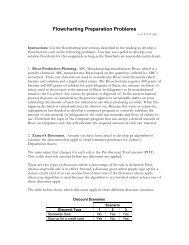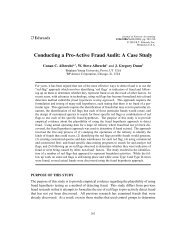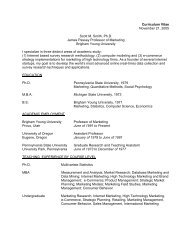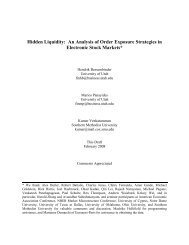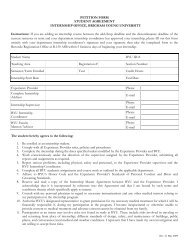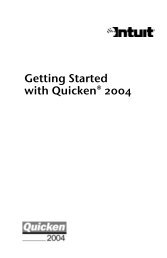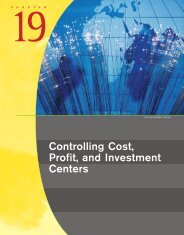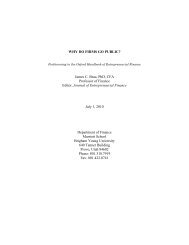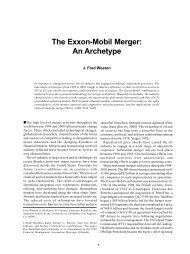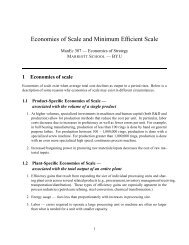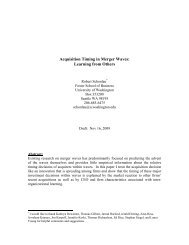The Limit Order Book and the Break-Even ... - Marriott School
The Limit Order Book and the Break-Even ... - Marriott School
The Limit Order Book and the Break-Even ... - Marriott School
Create successful ePaper yourself
Turn your PDF publications into a flip-book with our unique Google optimized e-Paper software.
THE LIMIT ORDER BOOK AND THE BREAK-EVEN CONDITIONS REVISITED 3<br />
we may not know how to compute those equilibria. In that case, we should question<br />
<strong>the</strong> break-even conditions paradigm.<br />
An alternative explanation is that in some economic environments <strong>the</strong> break even<br />
conditions should not be expressed in terms of expectation conditional on <strong>the</strong> order<br />
flow, as Rock (1990) <strong>and</strong> Glosten (1994) posit. Baruch (2008) studies a variant of<br />
<strong>the</strong> uniform example <strong>and</strong> finds an equilibrium with r<strong>and</strong>om limit orders. When limit<br />
orders are r<strong>and</strong>om, <strong>the</strong>re is an additional uncertainty about <strong>the</strong> execution of a limit<br />
order. In o<strong>the</strong>r words, conditional on execution, a liquidity supplier cannot infer<br />
whe<strong>the</strong>r <strong>the</strong> incoming market order is large or <strong>the</strong> book is thin. Indeed, <strong>the</strong> limit of<br />
equilibria in Baruch (2008) does not satisfy <strong>the</strong> Rock-Glosten conditions.<br />
<strong>The</strong> paper is organized as follows. In Section 1 we describe <strong>the</strong> economic environment.<br />
In Section 2 we state <strong>the</strong> Rock-Glosten break even conditions. In Section 3 we define<br />
<strong>the</strong> equilibrium, <strong>and</strong> in Section 4 we use <strong>the</strong> Bellman equation to derive a c<strong>and</strong>idate for<br />
equilibrium. In Section 5 we provide sufficient conditions for equilibrium <strong>and</strong> present<br />
two examples. In Section 6 we define <strong>the</strong> artificial game <strong>and</strong> present examples. In<br />
Section 7 we conclude.<br />
1. <strong>The</strong> Economic Environment<br />
We model a pure limit order market for a single risky asset. <strong>The</strong>re are two types of<br />
traders in <strong>the</strong> model: risk neutral, uninformed liquidity suppliers <strong>and</strong> a single active<br />
trader. Initially, <strong>the</strong> liquidity suppliers populate <strong>the</strong> limit order book. Those limit<br />
orders are <strong>the</strong>n prioritized by <strong>the</strong>ir limit prices (i.e., price priority rule is enforced).<br />
Next, <strong>the</strong> active trader observes all <strong>the</strong> bids <strong>and</strong> offers in <strong>the</strong> book <strong>and</strong> submits a<br />
market order. Based on <strong>the</strong>ir priority, limit orders are matched with <strong>the</strong> market<br />
order until <strong>the</strong> market order is completly filled (i.e., <strong>the</strong> market order “walks <strong>the</strong><br />
book”), <strong>and</strong> trade takes place at <strong>the</strong> limit prices (i.e., trading against limit orders is<br />
discriminatory). Following <strong>the</strong> trade, <strong>the</strong> asset is liquidated; <strong>the</strong> liquidation value is<br />
ṽ. Without loss of generality, we focus on <strong>the</strong> offer side of <strong>the</strong> book. 2<br />
<strong>The</strong> ask price is <strong>the</strong> smallest price at which offers are posted. Let y(·) denote <strong>the</strong><br />
supply function; i.e., <strong>the</strong> liquidity suppliers offer y(x) shares up to <strong>the</strong> price x. By<br />
definition, y(·) is positive <strong>and</strong> increasing, <strong>and</strong> it is strictly positive above <strong>the</strong> ask price<br />
<strong>and</strong> strictly increasing at all those prices that are populated with offers. To emphasize<br />
that <strong>the</strong> active trader observes <strong>the</strong> supply function, we denote <strong>the</strong> order size by ˜δ(y(·)).<br />
2 We don’t lose generality because <strong>the</strong> liquidity suppliers are uninformed.



